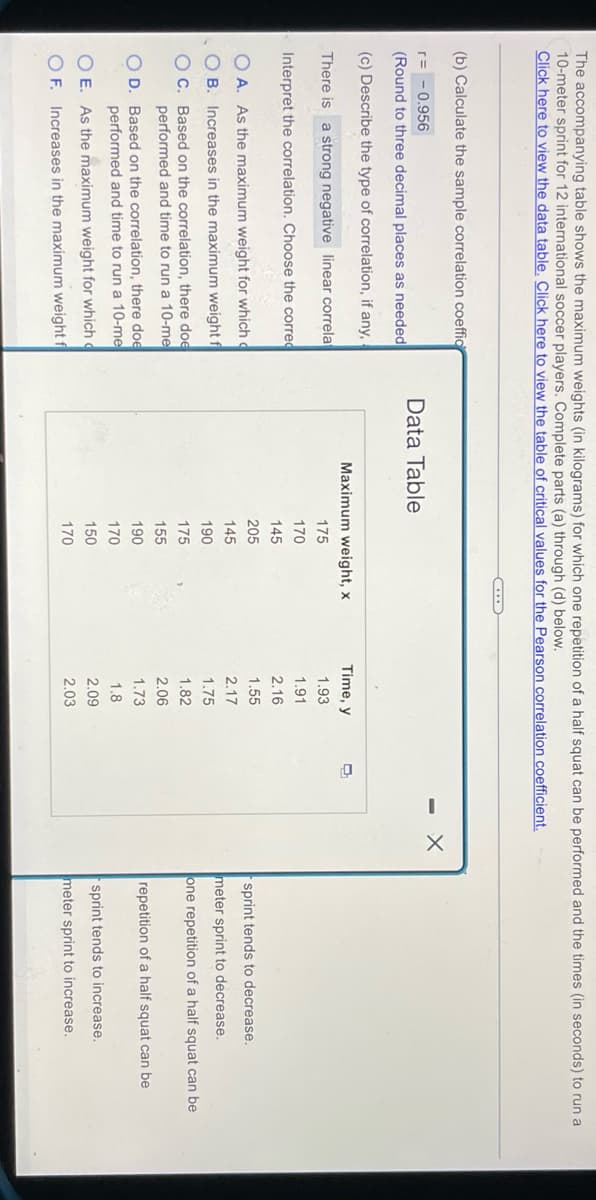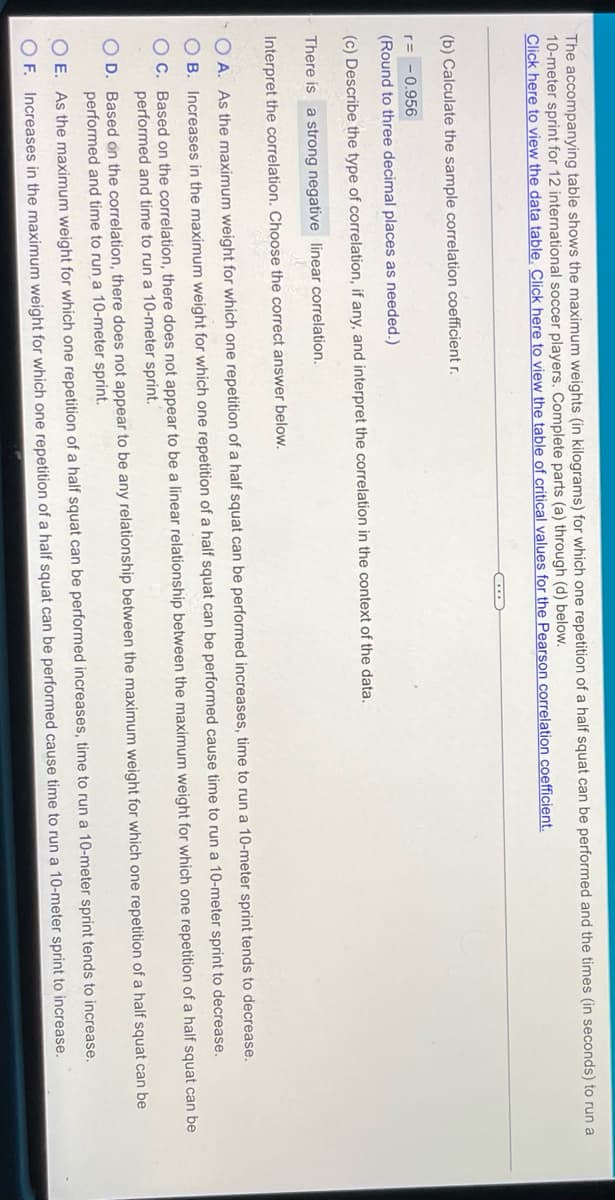The accompanying table shows the maximum weights (in kilograms) for which one repetition of a 10-meter sprint for 12 international soccer players. Complete parts (a) through (d) below. Click here to view the data table, Click here to view the table of critical values for the Pearson cOI (b) Calculate the sample correlation coefficient r. - 0.956 r= (Round to three decimal places as needed.) (c) Describe the type of correlation, if any, and interpret the correlation in the context of the data. There is a strong negative linear correlation. Interpret the correlation. Choose the correct answer below. O A. As the maximum weight for which one repetition of a half squat can be performed increa B. Increases in the maximum weight for which one repetition of a half squat can be perform O C. Based on the correlation, there does not appear to be a linear relationship between the and time to run a 10-meter sprint.
The accompanying table shows the maximum weights (in kilograms) for which one repetition of a 10-meter sprint for 12 international soccer players. Complete parts (a) through (d) below. Click here to view the data table, Click here to view the table of critical values for the Pearson cOI (b) Calculate the sample correlation coefficient r. - 0.956 r= (Round to three decimal places as needed.) (c) Describe the type of correlation, if any, and interpret the correlation in the context of the data. There is a strong negative linear correlation. Interpret the correlation. Choose the correct answer below. O A. As the maximum weight for which one repetition of a half squat can be performed increa B. Increases in the maximum weight for which one repetition of a half squat can be perform O C. Based on the correlation, there does not appear to be a linear relationship between the and time to run a 10-meter sprint.
Glencoe Algebra 1, Student Edition, 9780079039897, 0079039898, 2018
18th Edition
ISBN:9780079039897
Author:Carter
Publisher:Carter
Chapter10: Statistics
Section10.4: Distributions Of Data
Problem 19PFA
Related questions
Question

Transcribed Image Text:The accompanying table shows the maximum weights (in kilograms) for which one repetition of a half squat can be performed and the times (in seconds) to run a
10-meter sprint for 12 international soccer players. Complete parts (a) through (d) below.
Click here to view the data table. Click here to view the table of critical values for the Pearson correlation coefficient.
(b) Calculate the sample correlation coeffic
r= -0.956
- X
Data Table
(Round to three decimal places as needed
(c) Describe the type of correlation, if any,
Maximum weight, x
Time, y
There is a strong negative linear correla
175
1.93
Interpret the correlation. Choose the corred
170
1.91
145
2.16
205
1.55
O A. As the maximum weight for which
sprint tends to decrease.
145
2.17
O B. Increases in the maximum weight f
meter sprint to decrease.
190
1.75
OC. Based on the correlation, there doe
performed and time to run a 10-me
175
1.82
one repetition of a half squat can be
155
2.06
O D. Based on the correlation, there doe
performed and time to run a 10-me
190
1.73
repetition of a half squat can be
170
1.8
O E. As the maximum weight for which
150
2.09
sprint tends to increase.
O F. Increases in the maximum weight f
170
2.03
meter sprint to increase.

Transcribed Image Text:The accompanying table shows the maximum weights (in kilograms) for which one repetition of a half squat can be performed and the times (in seconds) to run a
10-meter sprint for 12 international soccer players. Complete parts (a) through (d) below.
Click here to view the data table. Click here to view the table of critical values for the Pearson correlation coefficient.
(b) Calculate the sample correlation coefficient r.
r= -0.956
(Round to three decimal places as needed.)
(c) Describe the type of correlation, if any, and interpret the correlation in the context of the data.
There is a strong negative linear correlation.
Interpret the correlation. Choose the correct answer below.
O A. As the maximum weight for which one repetition of a half squat can be performed increases, time to run a 10-meter sprint tends to decrease.
O B. Increases in the maximum weight for which one repetition of a half squat can be performed cause time to run a 10-meter sprint to decrease.
OC. Based on the correlation, there does not appear to be a linear relationship between the maximum weight for which one repetition of a half squat can be
performed and time to run a 10-meter sprint.
O D. Based on the correlation, there does not appear to be any relationship between the maximum weight for which one repetition of a half squat can be
performed and time to run a 10-meter sprint.
O E. As the maximum weight for which one repetition of a half squat can be performed increases, time to run a 10-meter sprint tends to increase.
O F. Increases in the maximum weight for which one repetition of a half squat can be performed cause time to run a 10-meter sprint to increase.
Expert Solution
This question has been solved!
Explore an expertly crafted, step-by-step solution for a thorough understanding of key concepts.
This is a popular solution!
Trending now
This is a popular solution!
Step by step
Solved in 4 steps with 4 images

Recommended textbooks for you

Glencoe Algebra 1, Student Edition, 9780079039897…
Algebra
ISBN:
9780079039897
Author:
Carter
Publisher:
McGraw Hill

Glencoe Algebra 1, Student Edition, 9780079039897…
Algebra
ISBN:
9780079039897
Author:
Carter
Publisher:
McGraw Hill